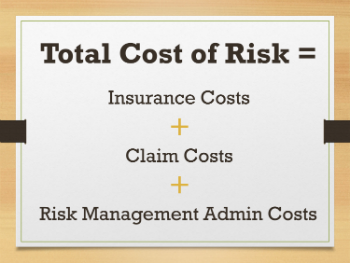 JODI MATHY
JODI MATHY
HNI Senior Claims Consultant
Many business leaders think about insurance and total risk management in two contexts: when they're paying insurance premiums and when they're dealing with claims.
The latter drives the former. Claims truly set the course for your insurance destiny. Your performance is measured by claims, and insurance carriers have a laser-like focus on your claims activity.
Can you change your destiny? Yes, and here's the key: Focus on TCOR — total cost of risk.
Your company's total cost of risk is equal to:
insurance costs (aka premiums) + claim costs (direct and indirect) + risk management administration costs
Your goal is to ID why your total cost of risk is higher than others in your industry. From there, you can plan an attack for bringing down that number — and for keeping value inside your organization (vs. letting it escape in unnecessary insurance-related costs).
Here's your five-point attack for total risk management:
1.) Starting at the Beginning
This means hiring and recruiting. Do recruits get the safety message? Does your safety culture come up in the interview process? Then there's investing in thorough background checks to learn who your new hire really is. Other tools include enhanced physicals for employees to make sure they can meet the physical requirements of the job free from injury. Because you have control over putting the right people in the right positions, you have a lot of control over your insurance destiny!
2.) Continue with Safety Training and Reinforcement
Safety should be second nature to all your people. It's about living it, and that's not hyperbole. Keep your manuals updated and available. Repeat safety training, and offer different types of training — online modules, in-person workshops, small groups, etc. Keeping safety on the minds of employees to create an environment where claims rarely occur.
3.) Prevent the Losses from Happening
Employ a dedicated safety manager whose chief purpose is nurturing your safety culture and developing claims management protocols. Take it from a claims pro at an insurance brokerage — safety is worth the investment. The money you spend now is saving you premium and claims dollars later! Spend on tools and resources for continuous improvement. Just because you hit your goal Mod now doesn't mean you can let up on your efforts. If your business is growing, you'll always have new risks to manage.
4.) React to Losses and Identify Root Causes
Empower your employees and tell them why your safety culture matters. Then share how you're going to prevent claims events in the future. With every claims scenario, you have to dig deep, because there's usually more to the story. Having the CFO/CEO sign off on loss reports and action plans shows that safety is critical at all levels. Safety committees are a powerful tool to educate employees. Your people will learn that when it comes to claims, the insurance companies aren't just writing a check — it's coming from your company! Soon workers will start watching out for other workers.
5.) Dominate the Management of the Claim
Some companies worry that they're being a pest when they reach out more than once to carriers regarding a claim. That's just not true. Carriers want to close claims fast, too, and you don't want to get lost in the shuffle. A company that's serious about superior claims management communicates with injured employees and makes sure they feel like their recovery is important. (Remember: A "caring" defense attorney is appealing when it feels like their employer has abandoned them.) A modified work program for a recovering employee is critical as well. There are placement organizations that even will match employees who need light-duty work with nonprofits that need extra hands. You can't control medical expenses, but you can control indemnity.
There are too many organizations that take a passive view of claims. We hear excuses such as, "The employee had a pre-existing condition," or "We can't control the weather," or "What's going on at my customer's location is out of our hands."
There's a lot you can do to control your claims (and improve your performance). Owning your risk lets you get back some of that value for your company that you've worked so hard to create!
What does total risk management look like at your organization? What's keeping your from owning more risk? Please sound off in comments!
Related Posts:
Employee Risk Management: What It Is and Why It Matters
Where Do You Fall on the Risk Assumption Continuum?
.png?width=69&height=53&name=Acrisure%20Logo%20(White%20Horizontal).png)

![[ HNI U LIVE EVENT ] Beat the Insurance Addiction & Stop Being at the Mercy of the Market - CLICK HERE TO RSVP -](https://no-cache.hubspot.com/cta/default/38664/88705dc9-001f-4951-82ee-17e8d052c48a.png)
